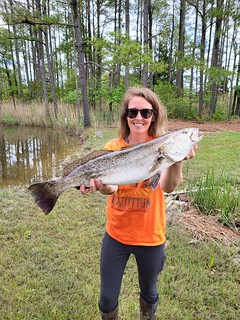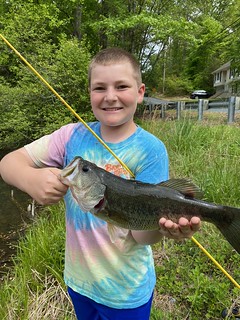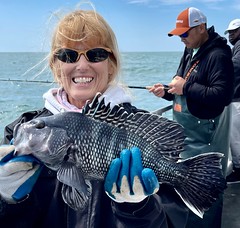Maryland Fishing Report – May 18

Glenn Simpkins and his daughter with a nice-sized crappie at a pond in Harford County. Photo by Glenn Simpkins
Warm and sunny weather returned to Maryland and fishing conditions are getting back to normal, with lighter winds and less rain this week.
The shad run is winding down, but should continue until the end of May. With the warmer weather, fishing for invasive snakeheads is starting to improve in the shallow waters of Blackwater and in other river systems, along the shorelines and weed beds.
Summer striped bass season regulations started May 16 and the entire Bay will be open to fishing starting on June 1 – be sure to check the DNR website for seasonal regulations in your area of the Bay.
Forecast Summary: May 18 – May 24:
For the first full week of striped bass season, expect sunny conditions and warming water temperatures. Chesapeake Bay surface water temperatures have increased since last week to the middle 60s, and will likely continue to rise all week. Warmest Bay waters will be found near the surface as well as near river mouths. Maryland rivers are currently running in the mid to upper 60s. There is plenty of oxygen for Bay fish from surface to bottom.
Expect above average flows for most Maryland rivers and streams all week. There will be above average tidal currents through Friday as a result of the May 16 full moon.
Expect average water clarity for most of the main Bay as well as many rivers and streams. Expect reduced water clarity from algal blooms in the Tolchester area of the main Bay as well as the Bush, Gunpowder, Back, Patapsco, upper Chester, Severn, and South rivers, as well as the middle Potomac River near Piney Point.
To see the latest water clarity conditions, check Eyes on the Bay Satellite Maps on the Maryland Department of Natural Resources website.
As always, best fishing areas could be further refined by intersecting them with underwater points, hard bottom, drop-offs, and large schools of baitfish. +
For more detailed and up-to-date fishing conditions in your area of the Bay, be sure to check out Eyes on the Bay’s Click Before You Cast.

Ryan “Rev. Big John” Johnson caught this 9-pound, 9-ounce, 32-inch snakehead on a Bill Lewis Red Craw RattleTrap lure. Photo by Ryan Johnson
At the Conowingo Dam, the flow rate has dropped down to near average levels. The shad run is winding down, but anglers should be able to do some catch-and-release fishing for American and hickory shad in the lower Susquehanna River, Deer Creek, and Octoraro Creek for another week. Shad anglers should use a combination of a shad dart and a small gold or silver spoon in tandem. Gold spoons tend to work best in cloudy water conditions, while silver spoons and red and white shad darts work in clear conditions. As always, experienced shad anglers carry a variety of colors and weights to adapt to changing river conditions.
Invasive blue catfish are still a reliable target species and can be found in almost every part of the upper Bay, with more channel catfish mixing in as the water gets warmer. We advise using stout tackle, a sinker heavy enough to hold bottom, and a circle-hook rig baited with fresh cut menhaden, gizzard shad, chicken liver or breast, clam snouts, or other catfish baits that can be purchased at local tackle shops.
As water flows subside and the shallow waters warm, fishing for white perch in the upper Bay’s tidal rivers should improve. The white perch are now moving to the lower river sections and towards mainstem Bay shorelines. Fishing with bottom rigs baited with grass shrimp or pieces of bloodworm, or small jigs tipped with grass shrimp or bloodworm, will entice white perch and a few stray yellow perch.
As always, we encourage anglers to target invasive northern snakeheads in the upper Bay and rivers. Fishing for snakeheads is improving as warmer water temperatures cause the fish to be more active, and they will strike bass-style lures. This invasive species can be found in every tidal river and creek in the upper Bay and the Susquehanna Flats. Casting white or chartreuse paddle tails, frogs, and buzzbaits are popular methods. Rigging a lip-hooked large minnow under a bobber can work well when the snakeheads are not striking artificial lures. All the rivers, coves, and tributaries around the north side of Baltimore, Essex, and Dundalk, including Dundee Creek, the Gunpowder, Bush, and Back rivers are good areas to target snakehead.
The summer striped bass season started on May 16, and the entire mainstem Bay, all the way to the Conowingo Dam, will be open June 1. The 2022 striped bass regulations are on the DNR website.
With the summer striped bass season now underway, anglers should downsize their trolling lures and also experiment with light-tackle jigging with leadheads and plastic skirted jigs with trailers. Trolling small bucktails, downsized shad-umbrella rigs, and red plastic hoses (surgical tube lures) along the shipping channel edges near Podickory Point, the Dumping Grounds, and near the Bay Bridge should produce the small to medium-sized summer striped bass in the upper Bay. The minimum size for fish to be kept is now 19 inches, with a limit of one fish per angler per day. If you chum or chunk for striped bass, you must use non-offset circle hooks, and fishing with live eels is not allowed. The beach at Sandy Point State Park and the Matapeake Fishing Pier will be popular places for shorebound anglers to fish with bait.
Striped bass anglers in the middle Bay are reminded that summer striped bass season started on May 16, with a 19-inch size limit; and some sections of tidal rivers are still closed. The entire Bay and all rivers will open on June 1.
With water temperatures still relatively cool, anglers are still trolling a few lingering large trophy striped bass from the Hill off Kent Island south to the gas docks area. Anglers may still find a few trophy striped bass until the end of May along the steep channel edges at the False Channel, RN2, and the steep channel edge south to the CP Buoy. The steep channel edges near Bloody Point, Buoy 83, and the western shore shipping channel edges from Thomas Point south past Breezy Point are always good places to troll.

With water temperatures increasing to the low 60s degree range, we are now starting to see bottlenose dolphins in the middle Bay. Herb Floyd photographed these dolphins in the Choptank River after volunteering for the MD Freedom Swim. Photo by Herb Floyd
Trolling parachutes, bucktails, and Mojos with large, 9-inch sassy shads in white or chartreuse rigged in tandem or behind umbrella rigs will catch some of the late season, lingering trophy striped bass. Downsizing your lures will catch more small and medium sized striped bass. Chartreuse colors tend to work better in turbid, muddy water and white works well in clear water.
Light-tackle jig and fly anglers enjoyed some success for striped bass during the first half of May. Good areas for light-tackle and fly casting include Eastern Bay, Poplar Island, and any areas where striped bass are suspended near channel edges. The warm water discharge plume at the Calvert Cliffs Nuclear Power Plant will most likely produce fish on jigs for the rest of May. Large soft plastic jigs in the 7-10 inch range on leadheads are used to target medium and large striped bass. Chunking for striped bass near Dollys Lump or Hackett’s Bar will produce some large striped bass, but you must use non-offset circle hooks.
Good fishing for invasive blue catfish in the tidal rivers should continue for the rest of May. The Choptank River and Nanticoke River are both good areas for targeting this invasive species. Cut menhaden or gizzard shad are excellent baits, while chicken liver, breast meat. or clam snouts can also work well. As the water warms up, increasing numbers of channel catfish will mix in with the blue catfish.
White perch have moved down to the middle and lower sections of the region’s tidal rivers, and should be starting to move out of the lower rivers to the Bay shorelines and drop offs around oyster reefs and other structure. Bottom rigs baited with grass shrimp or pieces of bloodworm are working the best in deeper waters. Small jigs tipped with grass shrimp or pieces of bloodworm can work also when fishing near structure, docks, and piers.

Angler Kaitryn Kelly caught a 25.5-inch spotted sea trout, which is the largest that we have seen reported this year. Photo by Kaitryn Kelly
Striped bass trophy season wrapped up on May 15, and we are now in the summer striped bass season in the lower Bay. Anglers have been trolling along the steep edges of the shipping channels with parachutes, bucktails, and Mojos dressed with large sassy shads. As usual, planer boards tend to produce more strikes by deploying a wide trolling spread, along with a few flat lines fished directly off the stern. Trollers will now be downsizing lures to smaller shad on umbrella rigs, double bucktail rigs, and plastic hoses (surgical tube lures).
Traditional areas to troll for medium and large striped bass will be the channel edges at Cove Point, Cedar Point, Point No Point, and Smith Point on the western side of the bay. On the eastern side, areas include the steep channel edges from the CP Buoy south to Buoy 76, 72B, and the main channel down the center of Tangier Sound. In the lower Potomac River, the steep channel edge from Piney Point to St. Georges Island and Point Lookout will be good bets for trolling action.
We have not received any red drum reports yet but we are getting exciting news that speckled trout have been showing up along the lower Eastern Shore marshes and shorelines, and they were being caught on paddle tail lures by kayak anglers. That fishery should improve as waters warm in the lower Bay.
Blue catfish will continue to offer fun fishing in the tidal rivers through May, and anglers can help the conservation effort to diminish this invasive fish and their predatory effects on native fish populations.
Northern snakeheads are another invasive fish that has spread across every tidal river in Maryland. This is an aggressive predator that feeds on native fish populations. The tributaries to the Potomac River tend to hold some of the largest concentrations of snakeheads. The upper Patuxent River and the rivers and creeks of southern Dorchester County on the Eastern Shore are a close second. Lately anglers have been having good luck casting frogs over patches of grass, and white or chartreuse paddle tails rigged weedless are always a popular bait. A large minnow rigged under a bobber is also a good tactic when lures are not producing.
As a reminder, the fishing piers at Bill Burton Fishing Pier State Park remain closed in both Dorchester and Talbot counties due to structural safety concerns. Shoreline and trail access is open on the Talbot County side of the park. More information is available on the DNR website.

Eric Packard’s grandson Isaac caught a nice bass in a small pond in Calvert County, casting a wacky worm rig. Photo by Eric Packard
Potomac River levels have come down from last week and should be more fishable. Boaters should still use caution as some ramps may still be coated with river mud, which is extremely slippery. Boaters should also watch for floating debris.
Largemouth bass are now in spawning and bedding mode. Anglers are reminded that largemouth bass may not be kept until after June 15 to protect spawning fish.
The male largemouth bass have carved out spawning beds in the shallow areas and the females are either on the beds or staged nearby in slightly deeper water. Targeting the largemouth bass that are holding in the deeper waters can be accomplished with small crankbaits, spinnerbaits, jerkbaits, and soft plastics. Any kind of structure such as sunken wood or deep grass are good places to target.
Fishing for crappie should be a good bet until waters become too warm; the cooler water temperatures allow the crappie to freely move in a variety of water depths. Structure is often the key – fallen treetops, sunken wood and brush, or marina docks are good places to look for crappie. Small marabou jigs or minnows under slip bobber, or casting jigs with a very slow retrieve are traditional methods for crappie.
Fishing along the Atlantic Ocean coastline and coastal bays has improved in recent days with dryer, warm weather and better sea conditions. A few bluefish have shown up in the surf and the Ocean City inlet, but we have not yet heard of very large numbers of these toothy fish. Prior to the storm there was some good action on black drum in the surf. Local surfcasters are catching black drum on sand fleas and clams. The clams are fastened to a 7/0 circle hook with dental floss or rubber bands. Clearnose skates continue to be pesky bait stealers, with some spiny dogfish in the mix. Anglers targeting bluefish should use cut or whole finger mullet, or cut menhaden.
A few large striped bass are being caught in the surf on cut menhaden.
Flounder are being caught in the inlet and Route 50 Bridge area, the Thorofare, and the channels leading from the inlet. The channels in Isle of Wight Bay and Sinepuxent Bay also provide good flounder fishing opportunities. Soft plastics such as Gulps will catch flounder as well as squid strips and minnows.
Black sea bass season got off to an excellent start on the offshore wreck and artificial reef sites. They are being caught on two hook bottom rigs baited with squid and clam. Black sea bass season opened on May 15, with a 13-inch minimum size limit and a daily bag limit of 15 fish per person. The season will be open until December 11.
Big news from the offshore canyons – the first bluefin and yellowfin tuna of the Ocean City season were caught on May 17 by the same boat. The crew also added another nine yellowfin for a total of 10. The fish were caught on skirted ballyhoo in 800 fathoms southeast of the Poorman’s Canyon.
“Fishing is much more than fish. It is the great occasion when we may return to the fine simplicity of our forefathers.” – Herbert Hoover.
Maryland Fishing Report was written and compiled by Erik Zlokovitz of Maryland DNR Recreational Fisheries Outreach, filling in for Keith Lockwood.
Click Before You Cast is written by Tidewater Ecosystem Assessment Director Tom Parham.
This report is now available on your Amazon Echo device — just ask Alexa to “open Maryland Fishing Report.”




 1-888-373-7888
1-888-373-7888 233733
233733